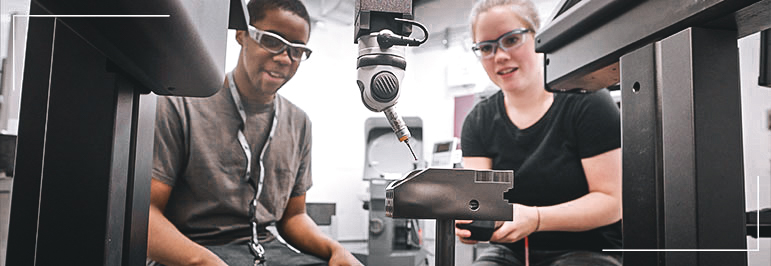Machining

Machining - AAS
Prepare for your career on your schedule with BTC’s newly updated flexible Machining program, where you’ll get hands-on learning with instructor-led shop time paired with interactive online content that you can complete at times that work for you.
Machinists drive our nation’s manufacturing, using technical expertise to cut metal, plastic, and other materials into precision parts that are critical to industry. Machinists set-up and run manual and computer numerical control (CNC) mills and lathes, then inspect their parts with precision measuring tools using blueprints with geometric dimensioning and tolerancing (GD&T). In BTC’s two-year Machining program, you’ll learn the real-world skills needed to make and verify components used in aerospace, marine, automotive, food and beverage processing, petroleum, mold making, medical device, musical instrument, and heavy equipment industries.
Graduates of the Machining program are prepared to work as entry-level machinists, CNC operators, and CNC programmers. With experience, you can advance to journey-level machinist, advanced CNC programmer, metrology technician, or engineer.
Employment Information
Data are provided on a program (not credential) level
75% BTC graduate placement rate1
$61,832 starting annual wage2
$88,103 average annual wage2
$99,158 potential annual wage2
Entry Information
When Can I Start?
Students may begin this program in Fall, Winter, Spring quarter.
What are the Minimum Entry Requirements?
A completed college admissions application and placement in English and math. BTC uses a Guided Self-Placement process to help you choose the best starting point for your English and math courses. Your selections will determine whether you begin with program coursework or complete prerequisites classes first.
To get started or for help determining your English and math placement, contact the Outreach department at Outreach@btc.edu.
What are My Next Steps?
Classes
Total Program Credits: 97
Quarter 1
MACH 110 Machining 1 Lab Extension 2 CR MACH 115 Blueprint Reading 1 5 CR MACH 181 Manual Machining 1 5 CR AMATH 100 Applied Occupational Math 5 CR or higher Quarter 2
MACH 112 Machining 2 Lab Extension 2 CR MACH 116 Blueprint Reading 2 5 CR MACH 182 Manual Machining 2 5 CR AENGL 100 Applied English 5 CR or higher Quarter 3
ENGR 180 Parametric Modeling 5 CR MACH 183 Introduction to CNC Machining and Programming 5 CR MACH 114 Machining 3 Lab Extension 4 CR CMST& 210 Interpersonal Communications 5 CR Quarter 4
MACH 241 Introduction to CNC Lathe Operation 5 CR MACH 251 Introduction to CNC Mill Operation 5 CR MACH 261 Introduction to CAD/CAM for Machining 3 CR QA 110 Introduction to Quality Assurance for Machining 3 CR Quarter 5
MACH 242 Advanced CNC Lathe Operation 5 CR MACH 252 Advanced CNC Mill Operation 5 CR MACH 263 Intermediate CAD/CAM for Machining 3 CR QA 115 Intermediate Quality Assurance for Machining 3 CR Quarter 6
MACH 264 Advanced CAD/CAM for Machining 3 CR MACH 274 CNC Machining for Production 6 CR QA 120 Advanced Quality Assurance for Machining 3 CR
Program Outcomes
After successfully completing the AAS degree, students will be able to:
- Operate machine shop equipment such as manual lathes, manual mills, and band saws.
- Read and interpret blueprints per industry standards with an emphasis on GD&T.
- Develop and execute a plan to create parts to print specifications.
- Read, write, and edit G-code.
- Create CNC programs using conversational programming.
- Operate CNC mills and lathes while using a variety of machine controls.
- Demonstrate competency in CAD and CAM software, with an emphasis on CAM programming to create complex toolpaths for both CNC mills and lathes.
- Validate parts using measuring equipment like calipers, micrometers, bore gages, electronic height gages, and CMMs.
Employment Outlook
Employment of machinists is expected to increase and employment of CNC operators is expected to increase.
Criminal convictions may restrict or prevent student participation with internships and employment in this industry.
Although most program graduates work as machinists, with experience, graduates can advance to positions such as journey level machinist, tool programmer, CNC operator/programmer, manager, engineer and machine and shop tools sales and service representative.
In addition, some graduates are self-employed. Around the country, most machinists work in small machining shops or in manufacturing firms that produce durable goods, such as metalworking and industrial machinery, aircraft, or motor vehicles.
Faculty & Support

Jacen Johnson
Machining
Jeffrey Halfacre
MachiningContacts
If you have questions about this program or want help with the admissions steps to Bellingham Technical College, please email outreach@btc.edu.
Current students wanting academic planning and support, can connect with the program Instructor(s) or email AdvancedManufacturingNav@btc.edu
